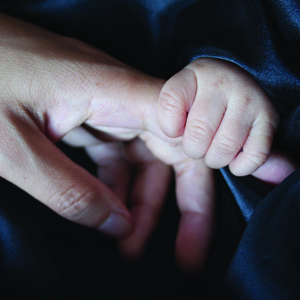Book Review – Depression after Childbirth by Dr. Katharina Dalton
 Dr. Katharina Dalton was a pioneer in women’s health, coining the term “premenstrual syndrome” (PMS) and recognizing that progesterone may relieve PMS symptoms. She then turned her attention to the complicated issue of depression after childbirth. Her book Depression after Childbirth: How to Recognize and Treat Postnatal Illness was first published in 1980 and categorized postpartum depression (PPD) according to its degrees of severity.
Dr. Katharina Dalton was a pioneer in women’s health, coining the term “premenstrual syndrome” (PMS) and recognizing that progesterone may relieve PMS symptoms. She then turned her attention to the complicated issue of depression after childbirth. Her book Depression after Childbirth: How to Recognize and Treat Postnatal Illness was first published in 1980 and categorized postpartum depression (PPD) according to its degrees of severity.
Causes and Characteristics of Postpartum Depression
As mothers experience hormonal fluctuations during and after childbirth, both their physical and emotional well-being are affected. Postpartum depression shares many symptoms in common with other forms of clinical depression, including:
- Lethargy or unusual fatigue
- Irritability
- Increased appetites
- Feel achy all over
- Isolation
- Increased risk of suicide
If you think you might be suffering from postpartum depression, contact your medical practitioner right away or go to the nearest emergency room.
In the mid-1960s, a group of physicians at the North Middlesex Hospital in London performed a survey of 500 of their pregnant patients before and after delivery. They found the women who were happiest, elated, and euphoric during the later months of their pregnancies had the highest risk for PPD. The mothers who developed PPD had two noticeable characteristics: a favorable attitude to motherhood, and labile emotions. Although PPD often begins early on after giving birth, it may also start when the mother stops breastfeeding, as another dramatic change in hormones occurs at that point. Postpartum depression may also occur after miscarriages, stillbirths, and terminations of pregnancies.
Levels of Severity in Postpartum Depression
Mild Postpartum Mood Changes: The “Blues”
Known as the “maternity blues,” “baby blues,” or “postnatal blues,” the mildest form of mood changes after a woman gives birth is also the most common. It often begins within three to ten days post-delivery but is usually subsides within one or two weeks. One of the main symptoms of the “blues” is excessive crying that begins suddenly and with no apparent reason.
In the early 1900s, women would usually stay in the hospital for 14 days after giving birth. This was generally enough time for this milder form of depression to fade away while having plenty of support from the hospital staff. Today, most women are sent home within 48 hours, often with little to no assistance unless family and friends pitch in.
Moderate Postpartum Depression: Postnatal Exhaustion, Depression, and Irritability
Tiredness and lethargy is another manifestation of PPD that may persist as long as six to nine months. Although difficulty in sleeping may be a symptom in other forms of clinical depression, women with PPD experience no problem sleeping and indeed, no amount of sleep seems to be enough. On the other hand, some patients may experience irritability that may be very difficult or impossible to control. The irritability may present in swings from anger to distress.
Dr. Dalton suspected that the plunge of hormones that occurs at delivery may be involved, and pointed out that low thyroid might be a factor along with low potassium and iron levels. A woman who has recently given birth should have her thyroid function tested if she exhibits one or more of the following symptoms:
- Falling asleep at any time day or night
- Experiencing lank and thinning hair
- Feeling cold
- Having a slow pulse
Fortunately, thyroid and other hormone levels can be evaluated by a woman’s healthcare provider, who may determine the use of hormone therapy necessary to correct any deficiencies or imbalances.
Severe Postpartum Depression: Psychosis
Psychosis is the most severe form of PPD that many times begins within two weeks after a woman gives birth. In psychosis, a woman may lose contact with reality and become unaware of her surroundings. She may have auditory hallucinations in which she hears voices or visual hallucinations in which she sees imaginary people, animals, or things. She may have ruminating thoughts, during which she can’t stop thinking about something.
Postpartum psychosis may require more drastic forms of treatment or even hospitalization. According to Dr. Dalton, progesterone therapy may prove helpful in addressing even these severe symptoms. As with any concern for mental wellness, it’s important to consult a medical professional in order to form a personalized treatment plan.
Similarities between Postpartum Depression and Premenstrual Syndrome
Dr. Dalton pointed out that the main features of PPD–tiredness, irritability, and depression–also characterize PMS. Both conditions also occur during a time of hormonal decline – prior to menses and following labor and delivery. Since these symptoms may arise from hormonal changes, proper supplementation with hormones such as progesterone and thyroid may provide relief. Dr. Dalton states: “The aim is to control the sudden drop in progesterone that normally occurs at delivery and prior to menses and convert it to a more gradual and slow fall.”
Another similarity between PPD and PMS is that fluctuations in blood sugar may occur. Low blood sugar brings on a surge of adrenaline (the “flight or fight” hormone), causing reactions such as fury or aggression. Appropriate diets may help stabilize blood sugar levels.
Preventing Postpartum Depression
Dr. Dalton concluded that the best practice for treating PPD is to prevent it from occurring in the first place. She suggested a treatment using progesterone (in injectable or suppository form) beginning at the completion of labor, and that progesterone supplementation should continue until a woman’s menstrual cycle resumes. Progesterone supplementation may be beneficial during breastfeeding, when the pituitary hormone prolactin increases, as excessive levels of prolactin may interfere with progesterone’s effectiveness.
Conclusion
Dr. Katharina Dalton correlated the similarities between PMS and PPD and argued that these were real medical conditions rooted in endocrine disorders. The marked mood changes a woman experiences after giving birth are not imaginary or “in her head.” On the contrary, Dr. Dalton’s groundbreaking work showed that these changes can be traced back to real physical causes, and may be remedied if the signs of postpartum depression are promptly identified and properly treated.
Written by Carol Petersen, RPh, CNP – Women’s International Pharmacy
Edited by Michelle Violi, PharmD – Women’s International Pharmacy




